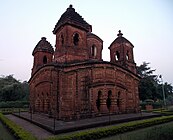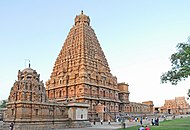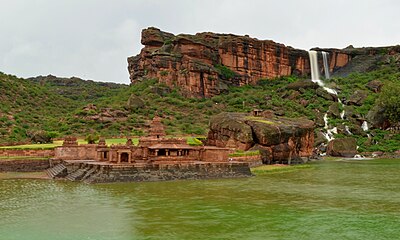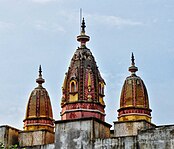Elements in a Hindu temple architecture.
The spiritual principles symbolically represented in Hindu temples are given in the ancient Sanskrit texts of India (for example, Vedas and Upanishads), while their structural rules are described in various ancient Sanskrit treatises on architecture (Brhat Samhita, Vastu Sastras).[9][10] The layout, the motifs, the plan and the building process recite ancient rituals, geometric symbolisms, and reflect beliefs and values innate within various schools of Hinduism.[3] A Hindu temple is a spiritual destination for many Hindus, as well as landmarks around which ancient arts, community celebrations and economy have flourished.[11][12]
Hindu temples come in many styles, are situated in diverse locations, deploy different construction methods and are adapted to different deities and regional beliefs,[13] yet almost all of them share certain core ideas, symbolism and themes. They are found in South Asia particularly India and Nepal, in southeast Asian countries such as Sri Lanka, Cambodia, Vietnam, and islands of Indonesia and Malaysia,[14][15] and countries such as Canada, the Caribbean, Fiji, France, Guyana, Kenya, Mauritius, the Netherlands, South Africa, Suriname, Tanzania, Trinidad and Tobago, Uganda, the United Kingdom, the United States, and countries with a significant Hindu community.[16] The current state and outer appearance of Hindu temples reflect arts, materials and designs as they evolved over two millennia; they also reflect the effect of conflicts between Hinduism and Islam since the 12th century.[17] The Swaminarayanan Akshardham in Robbinsville, New Jersey, United States, between the New York and Philadelphia metropolitan areas, was inaugurated in 2014 as one of the world's largest Hindu temples.[18]
Contents
- 1 Significance and meaning of a Hindu temple
- 2 Forms and designs of Hindu temples
- 3 Social functions of Hindu temples
- 4 Styles
- 5 Arts inside Hindu temples
- 6 Historical development and destruction
- 7 Customs and etiquette
- 8 Regional variations in Hindu temples
- 8.1 Nagara Architecture of North Indian temples
- 8.2 Temples in West Bengal
- 8.3 Temples in Odisha
- 8.4 Temples of Goa and other Konkani temples
- 8.5 South Indian and Sri Lankan temples
- 8.6 Temples in Cambodia
- 8.7 Temples in Nepal
- 8.8 Temples in Vietnam
- 8.9 Temples in Indonesia
- 8.10 Temples in Thailand
- 8.11 Temples outside Asia
- 9 Temple management
- 10 Etymology and nomenclature
- 11 See also
- 12 References
- 13 Bibliography
Significance and meaning of a Hindu temple
A Hindu temple reflects a synthesis of arts, the ideals of dharma, beliefs, values, and the way of life cherished under Hinduism. It is a link between man, deities, and the Universal Purusa in a sacred space.[19] It represents the triple-knowledge (trayi-vidya) of the Vedic vision by mapping the relationships between the cosmos (brahmanda) and the cell (pinda) by a unique plan that is based on astronomical numbers.[20] Subhash Kak sees the temple form and its iconography to be a natural expansion of Vedic ideology related to recursion, change and equivalence.[21]
The
9x9 (81) grid ‘’Parama Sayika’’ layout plan (above) found in large
ceremonial Hindu Temples. It is one of many grids used to build Hindu
temples. In this structure of symmetry, each concentric layer has
significance. The outermost layer, Paisachika padas, signify aspects of
Asuras and evil; while inner Devika padas signify aspects of Devas and
good. In between the good and evil is the concentric layer of Manusha
padas signifying human life; All these layers surround Brahma padas,
which signifies creative energy and the site for temple’s primary idol
for darsana. Finally at the very center of Brahma padas is Grabhgriya
(Purusa Space), signifying Universal Principle present in everything and
everyone.[3]
Susan Lewandowski states[9] that the underlying principle in a Hindu temple is built around the belief that all things are one, everything is connected. The pilgrim is welcomed through 64-grid or 81-grid mathematically structured spaces, a network of art, pillars with carvings and statues that display and celebrate the four important and necessary principles of human life – the pursuit of artha (prosperity, wealth), the pursuit of kama (pleasure, sex), the pursuit of dharma (virtues, ethical life) and the pursuit of moksha (release, self-knowledge).[22][23] At the center of the temple, typically below and sometimes above or next to the deity, is mere hollow space with no decoration, symbolically representing Purusa, the Supreme Principle, the sacred Universal, one without form, which is present everywhere, connects everything, and is the essence of everyone. A Hindu temple is meant to encourage reflection, facilitate purification of one’s mind, and trigger the process of inner realization within the devotee.[3] The specific process is left to the devotee’s school of belief. The primary deity of different Hindu temples varies to reflect this spiritual spectrum.[24][25]
In Hindu tradition, there is no dividing line between the secular and the lonely sacred.[9] In the same spirit, Hindu temples are not just sacred spaces, they are also secular spaces. Their meaning and purpose have extended beyond spiritual life to social rituals and daily life, offering thus a social meaning. Some temples have served as a venue to mark festivals, to celebrate arts through dance and music, to get married or commemorate marriages,[26] commemorate the birth of a child, other significant life events, or mark the death of a loved one. In political and economic life, Hindu temples have served as a venue for the succession within dynasties and landmarks around which economic activity thrived.[27]
Forms and designs of Hindu temples
Almost all Hindu temples take two forms: a house or a palace. A house-themed temple is a simple shelter which serves as a deity’s home. The temple is a place where the devotee visits, just like he or she would visit a friend or relative. The use of moveable and immoveable images is mentioned by Pāṇini. In Bhakti school of Hinduism, temples are venues for puja, which is a hospitality ritual, where the deity is honored, and where devotee calls upon, attends to and connects with the deity. In other schools of Hinduism, the person may simply perform jap, or meditation, or yoga, or introspection in his or her temple. Palace-themed temples often incorporate more elaborate and monumental architecture.Site
The appropriate site for a temple, suggest ancient Sanskrit texts, is near water and gardens, where lotus and flowers bloom, where swans, ducks and other birds are heard, where animals rest without fear of injury or harm.[3] These harmonious places were recommended in these texts with the explanation that such are the places where gods play, and thus the best site for Hindu temples.[3][9]
Hindu temple sites cover a wide range. The most common sites are those near water bodies, embedded in nature, such as the Bhutanatha temple complex at Badami, which is next to a waterfall.
While major Hindu temples are recommended at sangams (confluence of rivers), river banks, lakes and seashore, Brhat Samhita and Puranas suggest temples may also be built where a natural source of water is not present. Here too, they recommend that a pond be built preferably in front or to the left of the temple with water gardens. If water is neither present naturally nor by design, water is symbolically present at the consecration of temple or the deity. Temples may also be built, suggests Visnudharmottara in Part III of Chapter 93,[29] inside caves and carved stones, on hill tops affording peaceful views, mountain slopes overlooking beautiful valleys, inside forests and hermitages, next to gardens, or at the head of a town street.The gods always play where lakes are,
where the sun’s rays are warded off by umbrellas of lotus leaf clusters,
and where clear waterpaths are made by swans
whose breasts toss the white lotus hither and thither,
where swans, ducks, curleys and paddy birds are heard,
and animals rest nearby in the shade of Nicula trees on the river banks.
The gods always play where rivers have for their braclets
the sound of curleys and the voice of swans for their speech,
water as their garment, carps for their zone,
the flowering trees on their banks as earrings,
the confluence of rivers as their hips,
raised sand banks as breasts and plumage of swans their mantle.
The gods always play where groves are near, rivers, mountains and springs, and in towns with pleasure gardens.
— Brhat Samhita 1.60.4-8, 6th Century AD[28]
Manuals
Ancient builders of Hindu temples created manuals of architecture, called Vastu-Sastra (literally "science" of dwelling; vas-tu is a composite Sanskrit word; vas means "reside", tu means "you"); these contain Vastu-Vidya (literally, knowledge of dwelling).[30] There exist many Vastu-Sastras on the art of building temples, such as one by Thakkura Pheru, describing where and how temples should be built.[31][32] By the 6th century AD, Sanskrit manuals for in India.[33] Vastu-Sastra manuals included chapters on home construction, town planning,[30] and how efficient villages, towns and kingdoms integrated temples, water bodies and gardens within them to achieve harmony with nature.[34][35] While it is unclear, states Barnett,[36] as to whether these temple and town planning texts were theoretical studies and if or when they were properly implemented in practice, the manuals suggest that town planning and Hindu temples were conceived as ideals of art and integral part of Hindu social and spiritual life.[30]
Ancient
India produced many Sanskrit manuals for Hindu temple design and
construction, covering arrangement of spaces (above) to every aspect of
its completion. Yet, the Silpins were given wide latitude to experiment
and express their creativity.[37]
Ancient Sanskrit manuals for temple construction discovered in Rajasthan, in northwestern region of India, include Sutradhara Mandana’s Prasadamandana (literally, manual for planning and building a temple).[41] Manasara, a text of South Indian origin, estimated to be in circulation by the 7th century AD, is a guidebook on South Indian temple design and construction.[9][42] Isanasivagurudeva paddhati is another Sanskrit text from the 9th century describing the art of temple building in India in south and central India.[43][44] In north India, Brihat-samhita by Varāhamihira is the widely cited ancient Sanskrit manual from 6th century describing the design and construction of Nagara style of Hindu temples.[37][45][46]
The plan
Plan
Elements
of a Hindu temple in Kalinga style. There are many Hindu temple styles,
but they almost universally share common geometric principles,
symbolism of ideas, and expression of core beliefs.[3]
The four cardinal directions help create the axis of a Hindu temple, around which is formed a perfect square in the space available. The circle of mandala circumscribes the square. The square is considered divine for its perfection and as a symbolic product of knowledge and human thought, while circle is considered earthly, human and observed in everyday life (moon, sun, horizon, water drop, rainbow). Each supports the other.[3] The square is divided into perfect 64 (or in some cases 81) sub-squares called padas.[37][48] Each pada is conceptually assigned to a symbolic element, sometimes in the form of a deity. The central square(s) of the 64 or 81 grid is dedicated to the Brahman (not to be confused with Brahmin), and are called Brahma padas.
The 49 grid design is called Sthandila and of great importance in creative expressions of Hindu temples in South India, particularly in ‘‘Prakaras’’.[49] The symmetric Vastu-purusa-mandala grids are sometimes combined to form a temple superstructure with two or more attached squares.[50] The temples face sunrise, and the entrance for the devotee is typically this east side. The mandala pada facing sunrise is dedicated to Surya deity (Sun). The Surya pada is flanked by the padas of Satya (Truth) deity on one side and Indra (king of gods) deity on other. The east and north faces of most temples feature a mix of gods and demi-gods; while west and south feature demons and demi-gods related to the underworld.[51] This vastu purusha mandala plan and symbolism is systematically seen in ancient Hindu temples on Indian subcontinent as well as those in southeast Asia, with regional creativity and variations.[52][53]
Beneath the mandala’s central square(s) is the space for the formless shapeless all pervasive all connecting Universal Spirit, the highest reality, the purusha.[54] This space is sometimes referred to as garbha-griya (literally womb house) – a small, perfect square, windowless, enclosed space without ornamentation that represents universal essence.[47] In or near this space is typically a murti (idol). This is the main deity idol, and this varies with each temple. Often it is this idol that gives the temple a local name, such as Visnu temple, Krishna temple, Rama temple, Narayana temple, Siva temple, Lakshmi temple, Ganesha temple, Durga temple, Hanuman temple, Surya temple, and others.[19] It is this garbha-griya which devotees seek for ‘‘darsana’’ (literally, a sight of knowledge,[55] or vision[47]).
Above the vastu-purusha-mandala is a superstructure with a dome called Shikhara in north India, and Vimana in south India, that stretches towards the sky.[47] Sometimes, in makeshift temples, the dome may be replaced with symbolic bamboo with few leaves at the top. The vertical dimension's cupola or dome is designed as a pyramid, conical or other mountain-like shape, once again using principle of concentric circles and squares (see below).[3] Scholars suggest that this shape is inspired by cosmic mountain of Meru or Himalayan Kailasa, the abode of gods according to Vedic mythology.[47]
A
Hindu temple has a Shikhara (Vimana or Spire) that rises symmetrically
above the central core of the temple. These spires come in many designs
and shapes, but they all have mathematical precision and geometric
symbolism. One of the common principles found in Hindu temple spires is
circles and turning-squares theme (left), and a concentric layering
design (right) that flows from one to the other as it rises towards the
sky.[3][56]
Large temples also have pillared halls called mandapa. One on the east side, serves as the waiting room for pilgrims and devotees. The mandapa may be a separate structure in older temples, but in newer temples this space is integrated into the temple superstructure. Mega temple sites have a main temple surrounded by smaller temples and shrines, but these are still arranged by principles of symmetry, grids and mathematical precision. An important principle found in the layout of Hindu temples is mirroring and repeating fractal-like design structure,[57] each unique yet also repeating the central common principle, one which Susan Lewandowski refers to as "an organism of repeating cells".[27]
- Exceptions to the square grid principle
The symbolism
A Hindu temple is a symbolic reconstruction of the universe and universal principles that make everything in it function.[60][61] The temples reflect Hindu philosophy and its diverse views on cosmos and Truths.[57][62]Hinduism has no traditional ecclesiastical order, no centralized religious authorities, no governing body, no prophet(s) nor any binding holy book; Hindus can choose to be polytheistic, pantheistic, monistic, or atheistic.[63] Within this diffuse and open structure, spirituality in Hindu philosophy is an individual experience, and referred to as kṣaitrajña (Sanskrit: क्षैत्रज्ञ)[64]). It defines spiritual practice as one’s journey towards moksha, awareness of self, the discovery of higher truths, true nature of reality, and a consciousness that is liberated and content.[65][66] A Hindu temple reflects these core beliefs. The central core of almost all Hindu temples is not a large communal space; the temple is designed for the individual, a couple or a family – a small, private space where he or she experiences darsana.
Darsana is itself a symbolic word. In ancient Hindu scripts, darsana is the name of six methods or alternate viewpoints of understanding Truth.[67] These are Nyaya, Vaisesika, Sankhya, Yoga, Mimamsa and Vedanta – each of which flowered into their own schools of Hinduism, each of which are considered valid, alternate paths to understanding Truth and realizing Self in the Hindu way of life.
From names to forms, from images to stories carved into the walls of a temple, symbolism is everywhere in a Hindu temple. Life principles such as the pursuit of joy, sex, connection and emotional pleasure (kama) are fused into mystical, erotic and architectural forms in Hindu temples. These motifs and principles of human life are part of the sacred texts of Hindu, such as its Upanishads; the temples express these same principles in a different form, through art and spaces. For example, Brihadaranyaka Upanisad at 4.3.21, recites:
The architecture of Hindu temples is also symbolic. The whole structure fuses the daily life and it surroundings with the divine concepts, through a structure that is open yet raised on a terrace, transitioning from the secular towards the sacred,[69] inviting the visitor inwards towards the Brahma pada and temple’s central core, as well as lifting him upwards into a symbolic space marked by its spire (shikhara, vimana). The ancient temples had grand intricately carved entrances but no doors, and lacked a boundary wall. In most cultures, suggests Edmund Leach,[69] a boundary and gateway separates the secular and the sacred, and this gateway door is grand. In Hindu tradition, this is discarded in favor of an open and diffusive architecture, where the secular world was not separated from the sacred, but transitioned and flowed into the sacred.[70] The Hindu temple has structural walls, which were patterned usually within the 64 grid, or other geometric layouts. Yet the layout was open on all sides, except for the core space which had just one opening for darsana. The temple space is laid out in a series of courts (mandappas). The outermost regions may incorporate the negative and suffering side of life with symbolism of evil, asuras and rakshashas (demons); but in small temples this layer is dispensed with. When present, this outer region diffuse into the next inner layer that bridges as human space, followed by another inner Devika padas space and symbolic arts incorporating the positive and joyful side of life about the good and the gods. This divine space then concentrically diffuses inwards and lifts the guest to the core of the temple, where resides the main idol as well as the space for the Purusa and ideas held to be most sacred principles in Hindu tradition. The symbolism in the arts and temples of Hinduism, suggests Edmund Leach, is similar to those in Christianity and other major religions of the world.[71]In the embrace of his beloved a man forgets the whole world,
everything both within and without;
in the same way, he who embraces the Self,
knows neither within nor without.
— Brihadaranyaka Upanishad, 7th Century BC[68]
The teams that built Hindu temples
The 6th-century Brihat samhita
is a Sanskrit encyclopedia. Its chapters 57-60 discuss different styles
and design of Hindu temples. Above: the text and commentary in
Nepalaksara, Devanagari and Tamil Grantha scripts.
The Hindu manuals of temple construction describe the education, characteristics of good artists and architects. The general education of a Hindu Shilpin in ancient India included Lekha or Lipi (alphabet, reading and writing), Rupa (drawing and geometry), Ganana (arithmetic). These were imparted from age 5 to 12. The advanced students would continue in higher stages of Shilpa Sastra studies till the age of 25.[76][77] Apart from specialist technical competence, the manuals suggest that best Silpins for building a Hindu temple are those who know the essence of Vedas and Agamas, consider themselves as students, keep well verse with principles of traditional sciences and mathematics, painting and geography.[31] Further they are kind, free from jealousy, righteous, have their sense under control, of happy disposition, and ardent in everything they do.[43]
According to Silparatna, a Hindu temple project would start with a Yajamana (patron), and include a Sthapaka (guru, spiritual guide and architect-priest), a Sthapati (architect) who would design the building, a Sutragrahin (surveyor), and many Vardhakins (workers, masons, painters, plasterers, overseers) and Taksakas (sculptors).[31][45] While the temple is under construction, all those working on the temple were revered and considered sacerdotal by the patron as well as others witnessing the construction.[73] Further, it was a tradition that all tools and materials used in temple building and all creative work had the sanction of a sacrament.[31] For example, if a carpenter or sculptor needed to fell a tree or cut a rock from a hill, he would propitiate the tree or rock with prayers, seeking forgiveness for cutting it from its surroundings, and explaining his intent and purpose. The axe used to cut the tree would be anointed with butter to minimize the hurt to the tree.[43] Even in modern times, in some parts of India such as Odisha, Visvakarma Puja is a ritual festival every year where the craftsmen and artists worship their arts, tools and materials.[78]
Social functions of Hindu temples
Hindu Shiva temple depicted in a coin from the 1st century BCE.
Example of a Hindu temple constructed in the same manner as the one depicted in the coin.
The Golden Temple at Vellore is gilded with 1500 kg of pure gold.
In contemporary times, the process of building a Hindu temple by emigrants and diasporas from South Asia has also served as a process of building a community, a social venue to network, reduce prejudice and seek civil rights together.[85]
Library of manuscripts
| |||||
Palm-leaf manuscripts called lontar in dedicated stone libraries have been discovered by archaeologists at Hindu temples in Bali Indonesia and in 10th century Cambodian temples such as Angkor Wat and Banteay Srei.[89]
Temple schools
Inscriptions from the 4th century AD suggest the existence of schools around Hindu temples, called Ghatikas or Mathas, where the Vedas were studied.[90] In south India, 9th century Vedic schools attached to Hindu temples were called Calai or Salai, and these provided free boarding and lodging to students and scholars.[91][92] The temples linked to Bhakti movement in the early 2nd millennium, were dominated by non-Brahmins.[93] These assumed many educational functions, including the exposition, recitation and public discourses of Sanskrit and Vedic texts.[93] Some temple schools offered wide range of studies, ranging from Hindu scriptures to Buddhist texts, grammar, philosophy, martial arts, music and painting.[79][94] By the 8th century, Hindu temples also served as the social venue for tests, debates, team competition and Vedic recitals called Anyonyam.[79][94]Hospitals, community kitchen, monasteries
According to Kenneth G. Zysk – a professor specializing in Indology and ancient medicine, Hindu mathas and temples had by the 10th-century attached medical care along with their religious and educational roles.[95] This is evidenced by various inscriptions found in Bengal, Andhra Pradesh and elsewhere. An inscription dated to about AD 930 states the provision of a physician to two matha to care for the sick and destitute. Another inscription dated to 1069 at a Vishnu temple in Tamil Nadu describes a hospital attached to the temple, listing the nurses, physicians, medicines and beds for patients. Similarly, a stone inscription in Andhra Pradesh dated to about 1262 mentions the provision of a prasutishala (maternity house), vaidya (physician), an arogyashala (health house) and a viprasattra (hospice, kitchen) with the religious center where people from all social backgrounds could be fed and cared for.[95][96] According to Zysk, both Buddhist monasteries and Hindu religious centers provided facilities to care for the sick and needy in the 1st millennium, but with the destruction of Buddhist centers after the 12th century, the Hindu religious institutions assumed these social responsibilities.[95] According to George Michell, Hindu temples in South India were active charity centers and they provided free meal for wayfarers, pilgrims and devotees, as well as boarding facilities for students and hospitals for the sick.[97]The 15th and 16th century Hindu temples at Hampi featured storage spaces (temple granary, kottara), water tanks and kitchens.[98][99][100] Many major pilgrimage sites have featured dharmashalas since early times. These were attached to Hindu temples, particularly in South India, providing a bed and meal to pilgrims. They relied on any voluntary donation the visitor may leave and to land grants from local rulers.[101] Some temples have operated their kitchens on daily basis to serve the visitor and the needy, while others during major community gatherings or festivals. Examples include the major kitchens run by Hindu temples in Udupi (Karnataka), Puri (Odisha) and Tirupati (Andhra Pradesh). The tradition of sharing food in smaller temple is typically called prasada.[101][102]

























Such a peaceful and meaningful post! A temple for home creates a beautiful spiritual corner that adds calmness and positivity to everyday life. I love how a well-designed temple blends tradition with modern décor. I recently explored Vibecrafts’ collection, and their temples for home are truly elegant and thoughtfully crafted. Definitely worth checking out for a serene and stylish space!
ReplyDelete